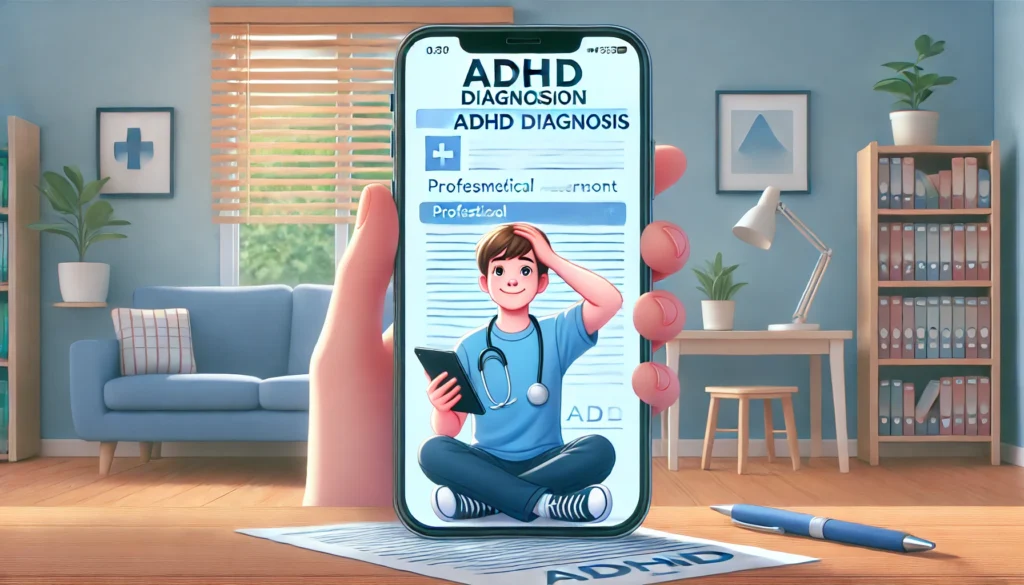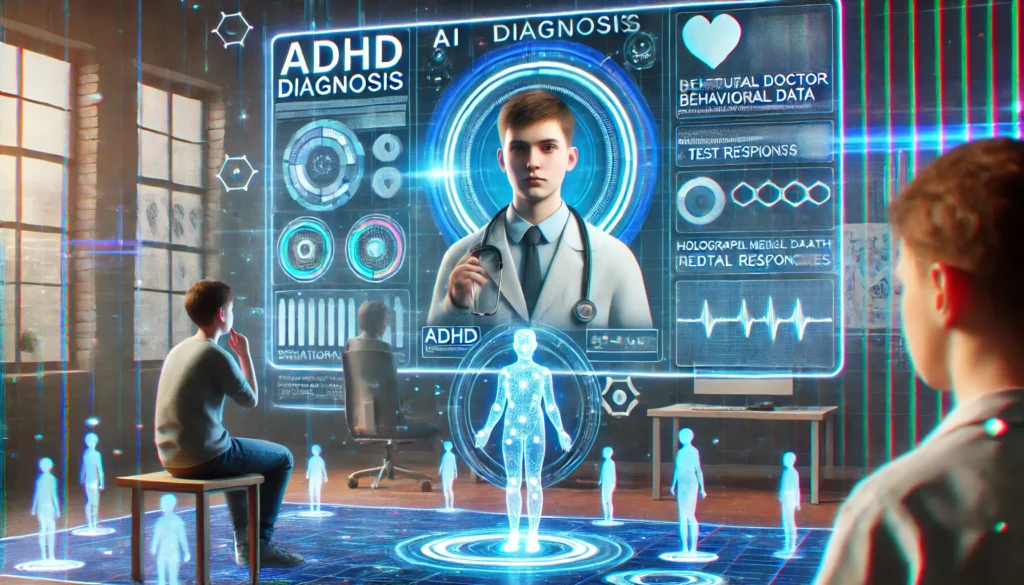ADHD is a neurodevelopmental disorder characterized by symptoms such as inattention, hyperactivity, and impulsiveness. Traditionally, diagnosing ADHD involved a lengthy process of in-person assessments, questionnaires, and observations. However, the evolution of telehealth has introduced a more streamlined approach, allowing individuals to seek a diagnosis from the comfort of their homes.
You may also like: Enhancing Concentration: Strategies for ADHD
The Traditional Diagnostic Process
Historically, ADHD diagnosis was a multi-step process that required several visits to healthcare providers. Patients had to undergo detailed interviews, psychological testing, and behavioral assessments. Each step was critical in piecing together the symptoms and their impact on the individual’s daily life. This traditional process, while thorough, was often time-consuming and required significant commitment from the patient and their family.
Symptoms and Challenges
ADHD symptoms can vary widely among individuals, making the diagnostic process complex. Inattention can manifest as forgetfulness, disorganization, or difficulty in completing tasks. Hyperactivity might be seen as an inability to sit still or excessive talking. Impulsiveness could lead to hasty decisions without considering consequences. These symptoms can affect academic performance, workplace productivity, and social interactions, making timely diagnosis crucial.
The Role of Awareness and Advocacy
The increase in ADHD awareness has been driven by advocacy groups, educational campaigns, and media coverage. These efforts have helped demystify the disorder and highlight its prevalence in both children and adults. As a result, more individuals are seeking evaluations, leading to a demand for more efficient diagnostic solutions. Online platforms have responded to this need by offering accessible services that cater to diverse populations.
Advantages of Virtual ADHD Diagnosis
Accessibility and Convenience
One of the most significant benefits of obtaining an ADHD diagnosis online is accessibility. Individuals in remote areas, those with mobility challenges, or those with busy schedules can easily access diagnostic services without geographical and logistical barriers. The convenience of virtual consultations eliminates the need for travel and long waiting times, enabling individuals to receive timely assessments.
Reaching Remote Areas
For those living in rural or underserved regions, accessing specialized healthcare can be challenging. Online ADHD diagnosis bridges this gap by providing services that transcend physical boundaries. Individuals who might otherwise forego a diagnosis due to distance can now engage with healthcare professionals from the comfort of their homes.
Overcoming Mobility Challenges
For individuals with physical disabilities or chronic illnesses, visiting a healthcare facility can be daunting. Online assessments offer a more inclusive alternative, accommodating those who may find traditional visits difficult. This approach ensures that everyone, regardless of physical ability, has the opportunity to seek the help they need.
Managing Busy Schedules
Modern life is hectic, and finding time to attend multiple in-person appointments can be difficult. Online ADHD diagnosis allows individuals to fit assessments into their schedules more easily. Virtual consultations can often be arranged outside regular office hours, providing greater flexibility for those balancing work, family, and other commitments.
Cost-Effectiveness
For many, the cost of healthcare can be a significant barrier. Online ADHD testing often provides a more affordable alternative to traditional in-person assessments. The reduction in overhead costs for providers, such as office space and administrative staff, typically results in lower fees for patients. Additionally, many online platforms offer competitive pricing, making it more feasible for individuals to seek help without financial strain.
Reduced Overhead Costs
Operating an online platform eliminates many of the fixed costs associated with traditional healthcare facilities. There is no need for extensive office space, waiting room areas, or large administrative teams. This reduction in overhead can translate into significant savings for both providers and patients.
Competitive Pricing Models
Many online diagnostic services offer tiered pricing options, allowing patients to choose a package that suits their budget. These models often include various levels of assessment, from basic screenings to comprehensive evaluations, providing flexibility and affordability to a wide range of clients.
Insurance and Payment Options
Some online ADHD diagnostic services are covered by insurance plans, further reducing out-of-pocket expenses for patients. Additionally, many platforms offer flexible payment options, including installment plans or sliding-scale fees, ensuring that financial constraints do not hinder access to necessary care.
Anonymity and Privacy
The stigma surrounding mental health issues can deter individuals from seeking a diagnosis. Online platforms often provide a sense of anonymity, which can alleviate concerns about privacy and judgment. This is particularly beneficial for those who are hesitant to seek help due to societal pressures or personal discomfort. Virtual environments can create a safe space where individuals feel more at ease discussing their symptoms.
Reducing Stigma
The anonymity afforded by online platforms can help reduce the stigma associated with ADHD and other mental health conditions. Patients may feel more comfortable discussing sensitive topics when they are not face-to-face with a clinician, fostering more open and honest communication.
Privacy in the Digital Age
Online ADHD diagnostic services prioritize patient confidentiality, employing encryption and secure data storage to protect personal information. This digital emphasis on privacy ensures that individuals can seek help without fear of their data being compromised or shared without consent.
Encouraging Honest Communication
In a virtual setting, individuals may feel less intimidated and more willing to disclose their true experiences. This honesty is crucial for accurate diagnosis and effective treatment planning. Online platforms often incorporate user-friendly interfaces and communication tools that encourage patients to share openly and thoroughly.
Comprehensive and Thorough Assessments
Online platforms dedicated to ADHD diagnostics often employ evidence-based approaches to ensure accuracy and reliability. These platforms typically use standardized questionnaires and behavioral assessments, administered by qualified healthcare professionals, to evaluate symptoms. The thoroughness of these assessments is comparable to traditional methods, providing patients with confidence in their diagnosis.
Evidence-Based Methodologies
Reputable online ADHD diagnostic services utilize well-established diagnostic criteria and evidence-based methodologies. These include standardized assessment tools and protocols that have been validated through research and clinical practice, ensuring that the diagnosis is both accurate and reliable.
Qualified Healthcare Professionals
Despite the virtual nature of the assessment, online platforms employ licensed and experienced healthcare professionals. These clinicians are trained to interpret assessment results, conduct virtual interviews, and provide a diagnosis that aligns with professional standards.
Ensuring Diagnostic Accuracy
To maintain high standards of care, online platforms often incorporate multiple assessment measures. This multifaceted approach helps cross-verify symptoms and ensures a comprehensive understanding of the individual’s experiences, ultimately leading to a more accurate diagnosis.

The Process of Getting Diagnosed Online
Initial Screening
The online ADHD diagnostic journey begins with an initial screening, usually consisting of a questionnaire designed to gauge the likelihood of ADHD. This preliminary step helps determine whether further assessment is warranted.
Designing Effective Screenings
The initial screening process is crucial in filtering out cases that require further evaluation. Online platforms design these questionnaires to capture a broad range of symptoms associated with ADHD. By covering various aspects of attention, behavior, and impulsivity, they can effectively identify individuals who may benefit from a more detailed assessment.
User-Friendly Interfaces
To encourage participation and accurate responses, initial screenings are presented in a user-friendly format. Platforms often use straightforward language and intuitive interfaces, making it easier for individuals of all ages and backgrounds to complete the questionnaire without confusion.
Immediate Feedback and Next Steps
Once the initial screening is completed, individuals receive immediate feedback regarding their results. This feedback often includes recommendations for further evaluation if necessary, guiding patients toward the next steps in their diagnostic journey with clarity and support.
In-Depth Evaluation
If the initial screening indicates the possibility of ADHD, a more detailed evaluation follows. This might involve comprehensive questionnaires, video consultations, and, in some cases, input from family members or educators. Healthcare professionals conduct these evaluations to ensure a holistic understanding of the individual’s symptoms and challenges.
Comprehensive Questionnaires
The in-depth evaluation phase typically involves detailed questionnaires that explore various dimensions of ADHD symptoms. These assessments are designed to gather specific information about the frequency, duration, and impact of symptoms on daily functioning, ensuring a thorough understanding of the individual’s experience.
Virtual Consultations
Video consultations allow healthcare professionals to observe patients’ behaviors and interactions in real-time, providing valuable insights into their symptoms. These sessions also offer an opportunity for patients to discuss their experiences more deeply, ask questions, and receive personalized feedback from clinicians.
Gathering Collaborative Input
In some cases, involving family members, educators, or colleagues can provide additional perspectives on the individual’s behavior and challenges. Online platforms often facilitate this collaboration through secure portals where third parties can submit observations and feedback, enriching the diagnostic process.
Diagnosis and Follow-Up
Upon completing the evaluation, healthcare professionals provide a diagnosis. They also offer recommendations for treatment and support, which might include behavioral therapy, medication, or lifestyle adjustments. Importantly, many online platforms offer follow-up consultations to monitor progress and adjust treatment plans as necessary.
Delivering the Diagnosis
Once all assessments are complete, clinicians provide a detailed diagnosis, explaining the findings and their implications. This information is often delivered via a secure online portal, accompanied by a comprehensive report that outlines the diagnostic criteria met and the rationale for the diagnosis.
Treatment Recommendations
Following the diagnosis, patients receive tailored recommendations for managing ADHD. These may include evidence-based treatment options such as cognitive-behavioral therapy, pharmacotherapy, or lifestyle changes. Online platforms often provide resources and referrals to help patients access these services.
Ongoing Support and Monitoring
Continuous support is essential for effective ADHD management. Many online diagnostic services offer follow-up consultations to review treatment progress, address any concerns, and make necessary adjustments to the care plan. This ongoing engagement ensures that patients receive the support they need to achieve optimal outcomes.

Current Trends and Future Implications
The rise in virtual ADHD diagnosis aligns with broader trends in telehealth and digital medicine. As technology continues to advance, we can expect even more sophisticated tools for diagnosing and managing ADHD. Artificial intelligence (AI) and machine learning hold promise for enhancing diagnostic accuracy and personalizing treatment plans. Additionally, the integration of wearable technology could offer real-time data on patient behavior, further refining diagnosis and management strategies.
Telehealth and Digital Medicine
Telehealth has revolutionized the way healthcare is delivered, breaking down traditional barriers and making services more accessible. The trend towards digital medicine is not just about convenience but also about improving the quality and reach of care. As more individuals and providers adopt these technologies, the standard of care is expected to rise, offering new possibilities for managing ADHD.
The Role of AI and Machine Learning
Artificial intelligence and machine learning are poised to transform ADHD diagnosis and management. These technologies can analyze vast amounts of data to identify patterns and predict outcomes, potentially leading to more accurate and personalized assessments. AI-powered tools may also assist clinicians in monitoring treatment progress and optimizing care plans based on individual responses.
Wearable Technology and Real-Time Data
Wearable devices, such as smartwatches and fitness trackers, can provide real-time data on various aspects of behavior and activity levels. Integrating this data into ADHD management could offer new insights into symptom patterns, helping to refine diagnoses and tailor interventions. This real-time feedback loop represents an exciting frontier in personalized healthcare.

Practical Advice for Those Considering Online Diagnosis
For individuals contemplating an online ADHD diagnosis, it’s crucial to choose a reputable platform. Look for services that employ licensed healthcare professionals and adhere to established guidelines for ADHD evaluation. Reading reviews and seeking recommendations can also provide insight into the quality of service offered by different platforms.
Choosing a Reputable Platform
When selecting an online diagnostic service, it’s important to ensure that the platform is reputable and trustworthy. Look for providers that are well-established, with a track record of delivering high-quality care. Verifying the credentials of the clinicians involved and ensuring that they are licensed and experienced is also essential.
Reviewing User Feedback
User reviews and testimonials can offer valuable insights into the experiences of others who have used the service. Pay attention to feedback regarding the ease of use, the professionalism of the healthcare providers, and the overall satisfaction with the diagnostic process. This information can help guide your decision-making.
The Importance of Comprehensive Care
While an online diagnosis can provide clarity and direction, it’s important to approach ADHD management holistically. Engage with a full spectrum of care options, including therapy, support groups, and lifestyle modifications. These complementary approaches can enhance overall well-being and improve long-term outcomes.
Conclusion
The ability to get an ADHD diagnosis online is a transformative development in mental health care, offering accessibility, convenience, and privacy to individuals worldwide. As we continue to embrace digital health solutions, understanding the benefits and limitations of virtual diagnoses is essential. Whether you’re navigating your own ADHD journey or supporting others, being informed about these advancements empowers us to make better health choices.
Democratizing Access to Healthcare
The shift towards virtual diagnosis not only democratizes access to healthcare but also paves the way for innovative approaches to mental health management. It ensures that individuals from all walks of life, regardless of location or circumstance, have the opportunity to receive timely and effective care.
Embracing Innovation and Inclusion
Embracing these changes can lead to more inclusive and effective care for those with ADHD, ultimately improving quality of life and expanding opportunities for personal and professional growth. By staying informed and open to new possibilities, we can contribute to a future where mental health care is accessible, personalized, and stigma-free.
The Path Forward
As technology continues to evolve, the landscape of ADHD diagnosis and management will undoubtedly change. By keeping abreast of these developments and remaining engaged with the latest advancements, we can ensure that we are well-equipped to support ourselves and others on the journey towards better mental health.
Further Reading:
Treatment for ADHD online with a psychiatrist
Online ADHD Assessment & Diagnosis
Is ADHD online diagnosis legit?
Important Note: The information contained in this article is for general informational purposes only, and should not be construed as health or medical advice, nor is it intended to diagnose, prevent, treat, or cure any disease or health condition. Before embarking on any diet, fitness regimen, or program of nutritional supplementation, it is advisable to consult your healthcare professional in order to determine its safety and probable efficacy in terms of your individual state of health.
Regarding Nutritional Supplements Or Other Non-Prescription Health Products: If any nutritional supplements or other non-prescription health products are mentioned in the foregoing article, any claims or statements made about them have not been evaluated by the U.S. Food and Drug Administration, and such nutritional supplements or other health products are not intended to diagnose, treat, cure, or prevent any disease.


